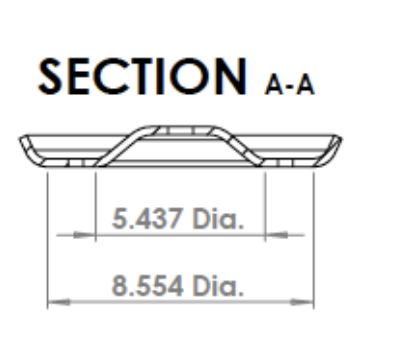SnapPad PRIME surface area calculationsUpdated 4 months ago
Most landing feet have a 2” diameter bolt hole (or indent) that doesn’t contact the ground, the Power Gear jack foot is different though, as this bolt hole is considerably larger.
Let's look at the cross-section of the engineering drawings of the landing foot to get a better understanding of what part of the pad contacts the ground, and then calculate that surface area.
The formula to calculate the area of a circle is A = π r² where A is the area of the circle and r is the radius of the circle.
So, if the inner circle has a diameter of 5.437”, the radius will be 2.7185”, and the surface area is therefore 23.22 in².
The outer circle will have a surface area of 57.47 in² using these same formulas.
To then get the surface area of the part of the jack foot in contact with the ground we subtract the inner circle from the outer circle, giving us an area of 34.25 in².
Calculating the surface area of an octagon is a little trickier. The formula is A = 2 * a² * (1 + √2) where a = e / (1 + √2) (e is the measurement we use for the diameter).
So, for our PRIME pad, e (the diameter) is 13.25”, so a = 13.25 / (1 + √2) or a = 5.488”
Solving for the surface area of the pad is then A = 2 * 5.4882² * (1 + √2) or A = 145.441 in².
We then need to subtract the area that the 2” bolt access hole in the SnapPad removes from the pad (which is 3.14 in²). That leaves us with 142.30 in² (if we round to two decimals).
Finally, we need to calculate the percent increase in surface area that the SnapPad provides. To do this we first need to find out how much bigger the area of the SnapPad is compared to the area of the jack foot to find the increase. For the PRIME pad it’s 142.30 - 34.25 = 108.05 in².
We then need to divide that number by the original landing foot size and multiply by 100 to get the percent increase. So for our PRIME pad we take 108.05 / 34.25 = 3.155 * 100 = 315.5%. For the purpose of simplicity, we rounded up to 316%. That is an increase in surface area for each jack foot.